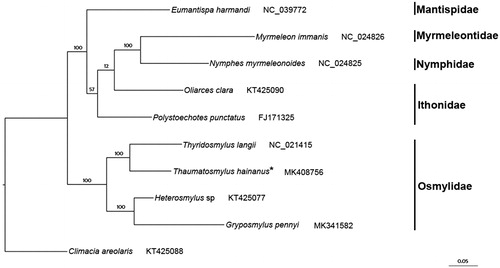Abstract
The complete mitochondrial genome (mitogenome) of Thaumatosmylus hainanus is described in the present paper. The sequenced mitogenome is 16029 bp in length containing the typical set of 37 genes, including 13 protein-coding genes (PCGs), 22 tRNA genes, 2 rRNA genes, and 1 control region. Besides COI initiates with TCG, the remaining 12 PCGs use ATN as the start codon. Most of the PCGs terminate with TAA codons but COII, CytB, ND4, and ND5 with a single T residue. The lrRNA and srRNA genes are 1330 bp and 794 bp in length, respectively. The control region is 1105 bp along with A + T content of 90.2%. The phylogenetic result supports the monophyly of the family Osmylidae and a closer relationship between Thaumatosmylus and Thyridosmylus that belong to the same subfamily Spilosmylinae.
Thaumatosmylus Krüger, 1913 is a small genus within Spilosmylinae (Neuroptera, Osmylidae) including eight species and is distributed in the Oriental region (Wang Citation2010). In this study, the complete mitochondrial genome (mitogenome) of T. hainanus was reported and the phylogenetic relationship was reconstructed combining the current mitogenome data of the other three osmylid species and six species belonging to five neuropteran families, e.g. Ithonidae, Mantispidae, Myrmeleontidae, Nymphidae, and Sisyridae.
The specimen was collected from Yinshan Park at Mountain Dayao in Guangxi province, China. Voucher specimen (No. CAU-Ta-H2) was deposited at the Entomological Museum of China Agricultural University (CAU). The complete mitogenome was obtained by next-generation sequencing method with Illumina Hiseq 2500 (Berry Genomics, Beijing) and the sequence was deposited in GenBank under the accession number MK408756.
The whole mitogenome is a circular DNA molecule with 16,029 bp in length and the nucleotide composition of the mitogenome is significantly biased towards A + T (77.9%) with negative AT-skew (−0.017) and negative GC-skew (−0.203). A total of 37 genes are identified, including 13 protein-coding genes (PCGs), 22 tRNA genes, 2 rRNA genes, and 1 control region. The gene arrangement is consistent with the putative ancestor of insects and also other two osmylid species, Heterosmylus sp. and T. langii (Boore Citation1999; Zhao et al. Citation2013; Wang et al. Citation2017). All PCGs start with ATG codon except for ATP8/ND5 (ATC), COI (TCG), ND1/ND6 (ATT), ND3 (ATA). The conservative stop codon TAA is shared with. All of the PCGs terminates with the complete stop codon (TAA for ATP6, ATP8, COI, COIII, ND2, ND3, ND4L, ND6; TAG for ND1) except for four PCGs, including COII, CytB, ND4, and ND5, with a single T residue. The lrRNA is 1330 bp in length with an A + T content of 81.2% and the srRNA is 794 bp in length with an A + T content of 81.1%. The control region located between the srRNA and tRNAIle is 1105 bp with A + T content of 90.2%. Except for the control region, 17 inter-genic regions are present in the whole genome, ranging from 1 to 66 bp in size. There are totally 30 bp overlapped nucleotides between neighboring genes in eight locations, ranging from 1 to 8 bp in size.
Phylogenetic tree was constructed based on the sequences of 13 protein-coding genes and 2 rRNA genes from 10 neuropteran species by using RAxML-HPC2 (Stamatakis Citation2014) with maximum-likelihood (ML) method under the GTR + CAT model () (Song et al. Citation2016; Li et al. Citation2017; Liu et al. Citation2018). The result supports the monophyly of the family Osmylidae and the grouping of Thaumatosmylus and Thyridosmylus that belongs to the subfamily Spilosmylinae. This phylogenetic relationship is in accordance with the current phylogeny of Osmylidae (Winterton et al. Citation2017).
Figure 1. Phylogenetic tree inferred from ML analysis of the nucleotide of the 13 PCGs and 2 rRNA genes (13129 bp). The nodal numbers indicate the bootstrap values obtained with 1000 replicates. Genbank accession numbers for the sequences are indicated next to the species names. The newly sequenced mitogenome is indicated by the asterisk.

Disclosure statement
All authors have read and approved the final manuscript. The authors report no conflicts of interest. The authors alone are responsible for the content and writing of the paper.
Additional information
Funding
References
- Boore JL. 1999. Animal mitochondrial genomes. Nucleic Acids Res. 27:1767–1780.
- Li H, Leavengood JM, Jr, Chapman EG, Burkhardt D, Song F, Jiang P, Liu JP, Zhou XG, Cai WZ. 2017. Mitochondrial phylogenomics of Hemiptera reveals adaptive innovations driving the diversification of truebugs. Proc Royal Soc B. 284:20171223.
- Liu YQ, Song F, Jiang P, Wilson JJ, Cai WZ, Li H. 2018. Compositional heterogeneity in true bug mitochondrial phylogenomics. Mol Phylogenet Evol. 118:135–144.
- Song F, Li H, Jiang P, Zhou XG, Liu JP, Sun CH, Vogler A, Cai WZ. 2016. Capturing the phylogeny of Holometabola with mitochondrial genome data and Bayesian site-heterogeneous mixture models. Genome Biol Evol. 8:1411–1426.
- Stamatakis A. 2014. RAxML version 8: a tool for phylogenetic analysis and post-analysis of large phylogenies. Bioinformatics. 30:1312–1313.
- Wang YJ. 2010. Systematics of extant Osmylidae and Mesozoic osmylid-like families from China (Insecta: Neuroptera) [Ph.D. dissertation]. Beijing: Chinese Agricultural University; p. 118.
- Wang YY, Liu XY, Garzón‐Orduña IJ, Winterton SL, Yan Y, Aspöck U, Aspöck H, Yang D. 2017. Mitochondrial phylogenomics illuminates the evolutionary history of Neuropterida. Cladistics. 33:617–636.
- Winterton SL, Zhao J, Garzón-Orduña IJ, Wang YJ, Liu ZQ. 2017. The phylogeny of lance lacewings (Neuroptera: Osmylidae). Syst Entomol. 42:555–574.
- Zhao J, Li H, Winterton SL, Liu ZQ. 2013. Ancestral gene organization in the mitochondrial genome of Thyridosmylus langii (McLachlan, 1870) (Neuroptera: Osmylidae) and implications for lacewing evolution. PLoS ONE. 8:e62943.
